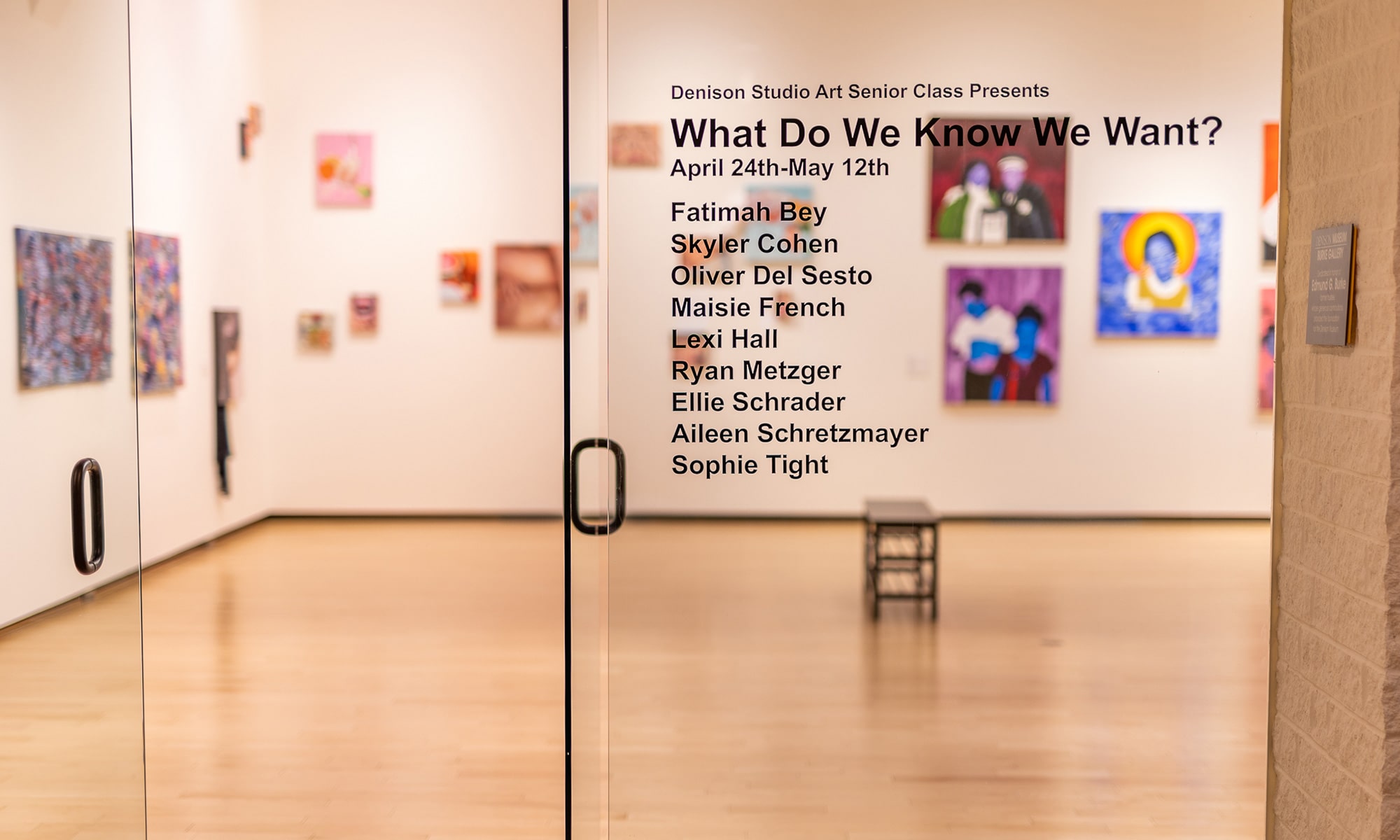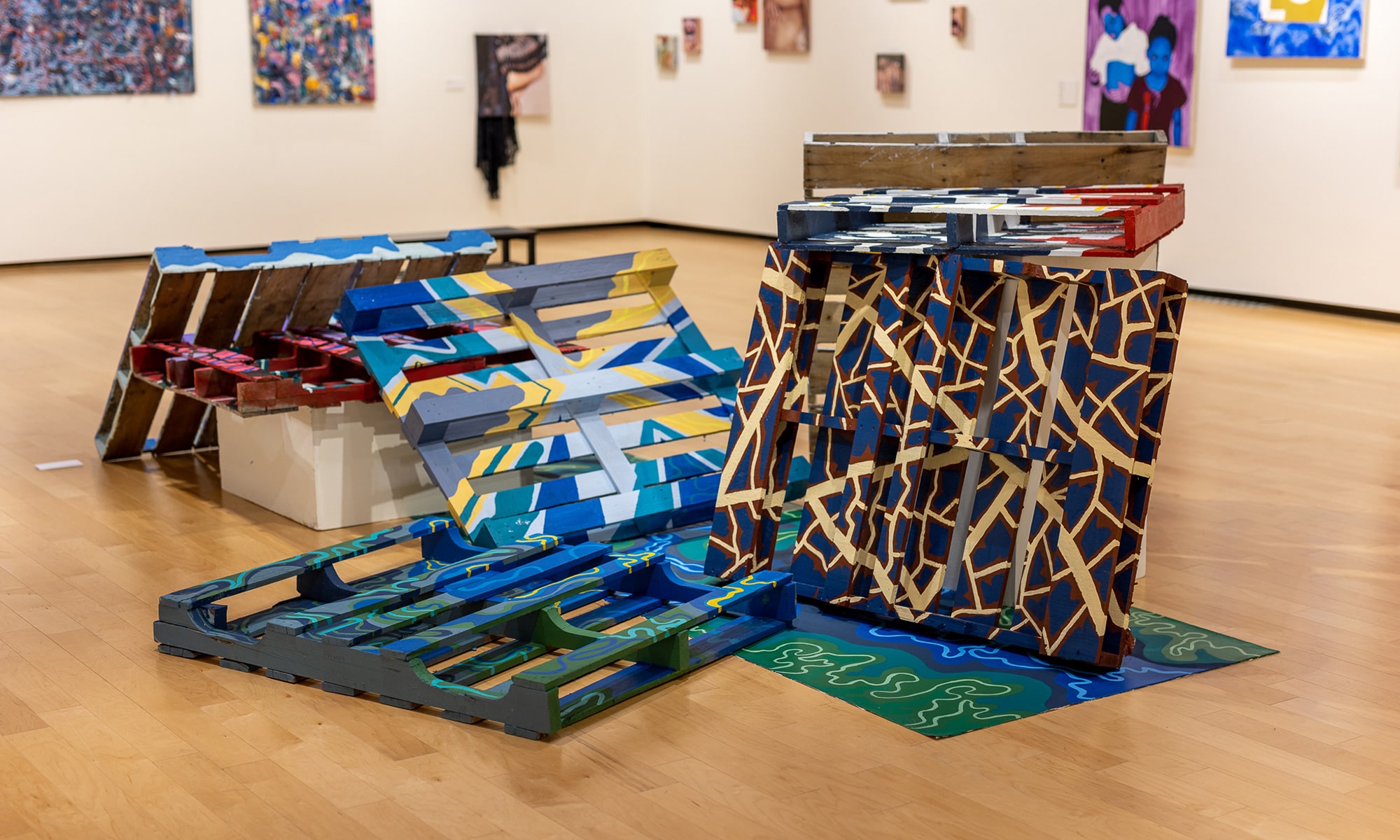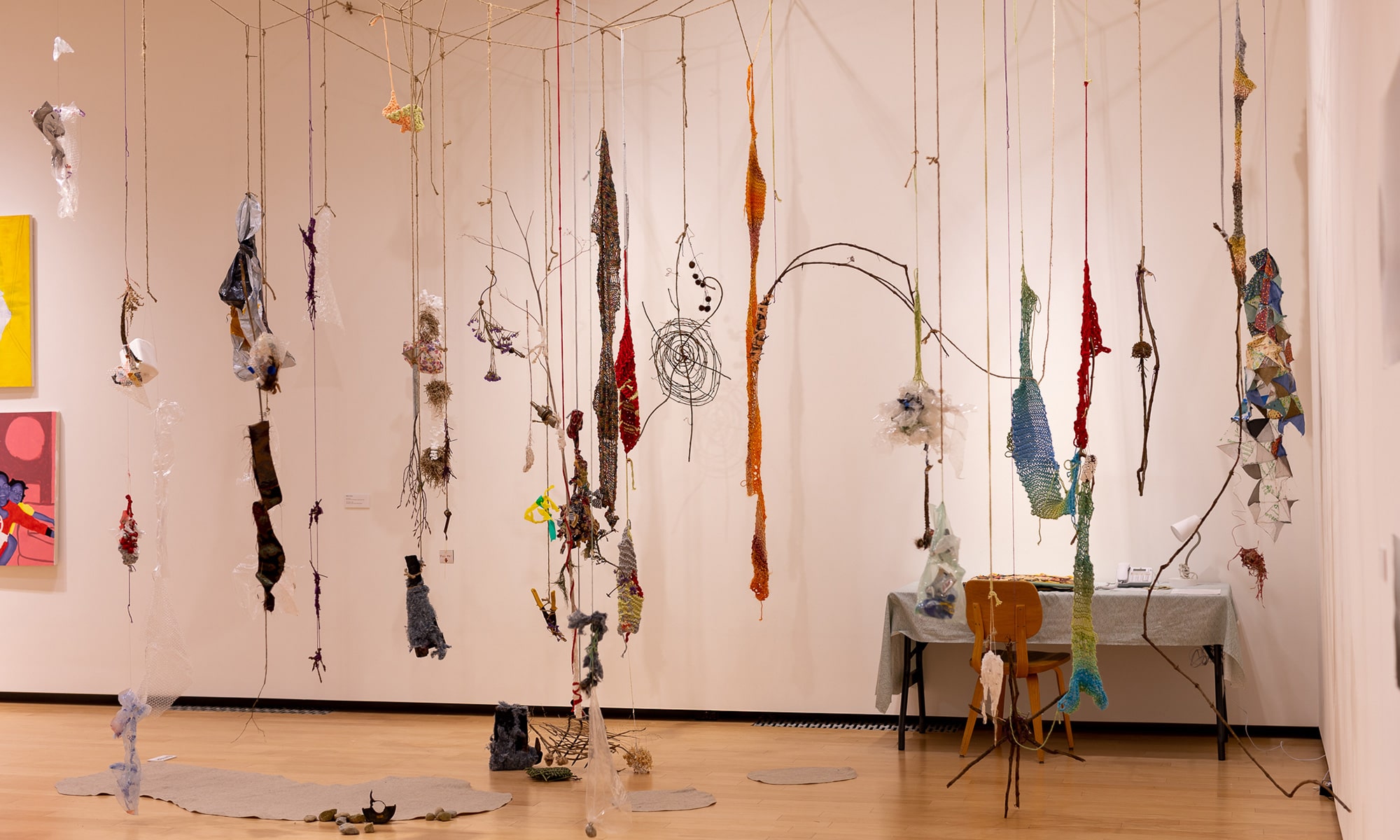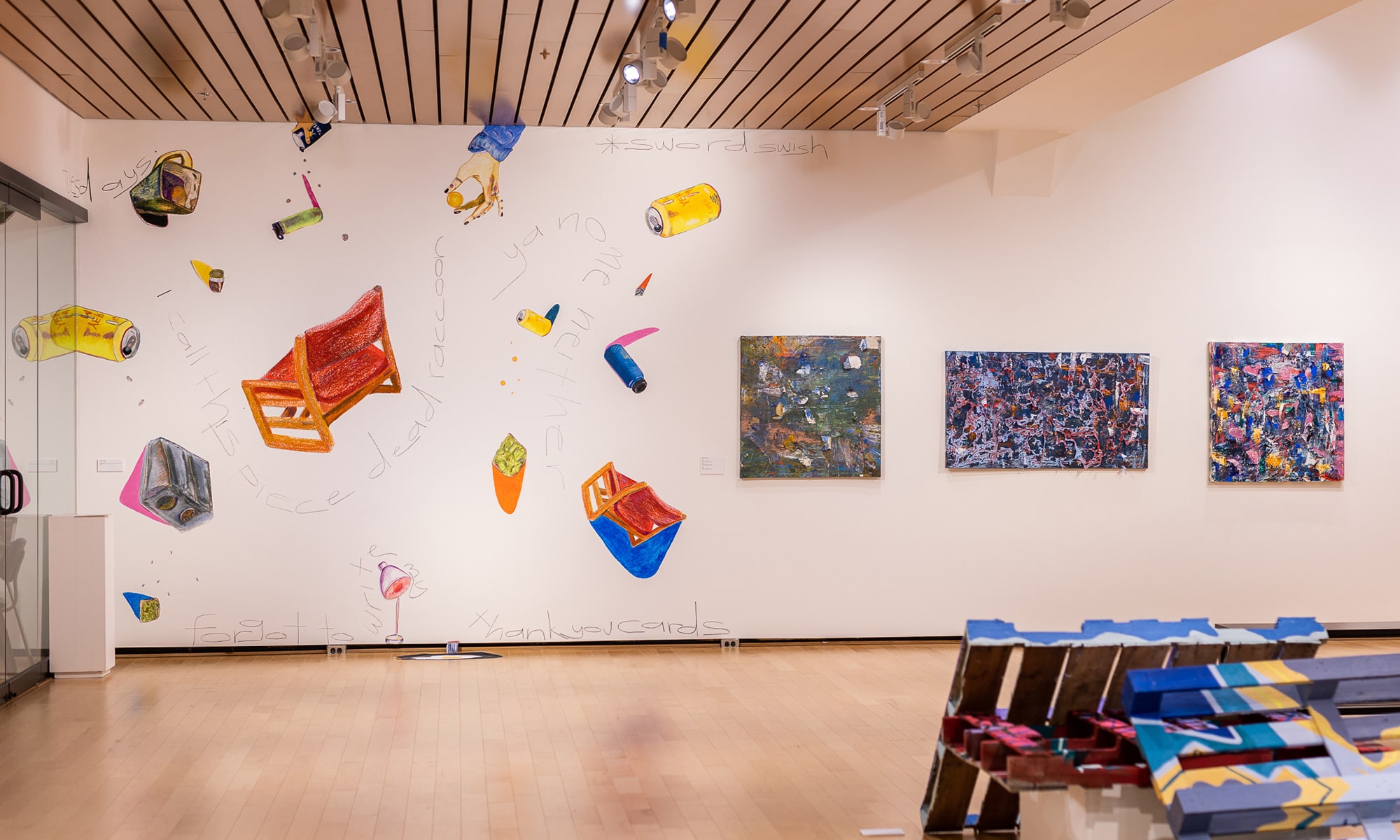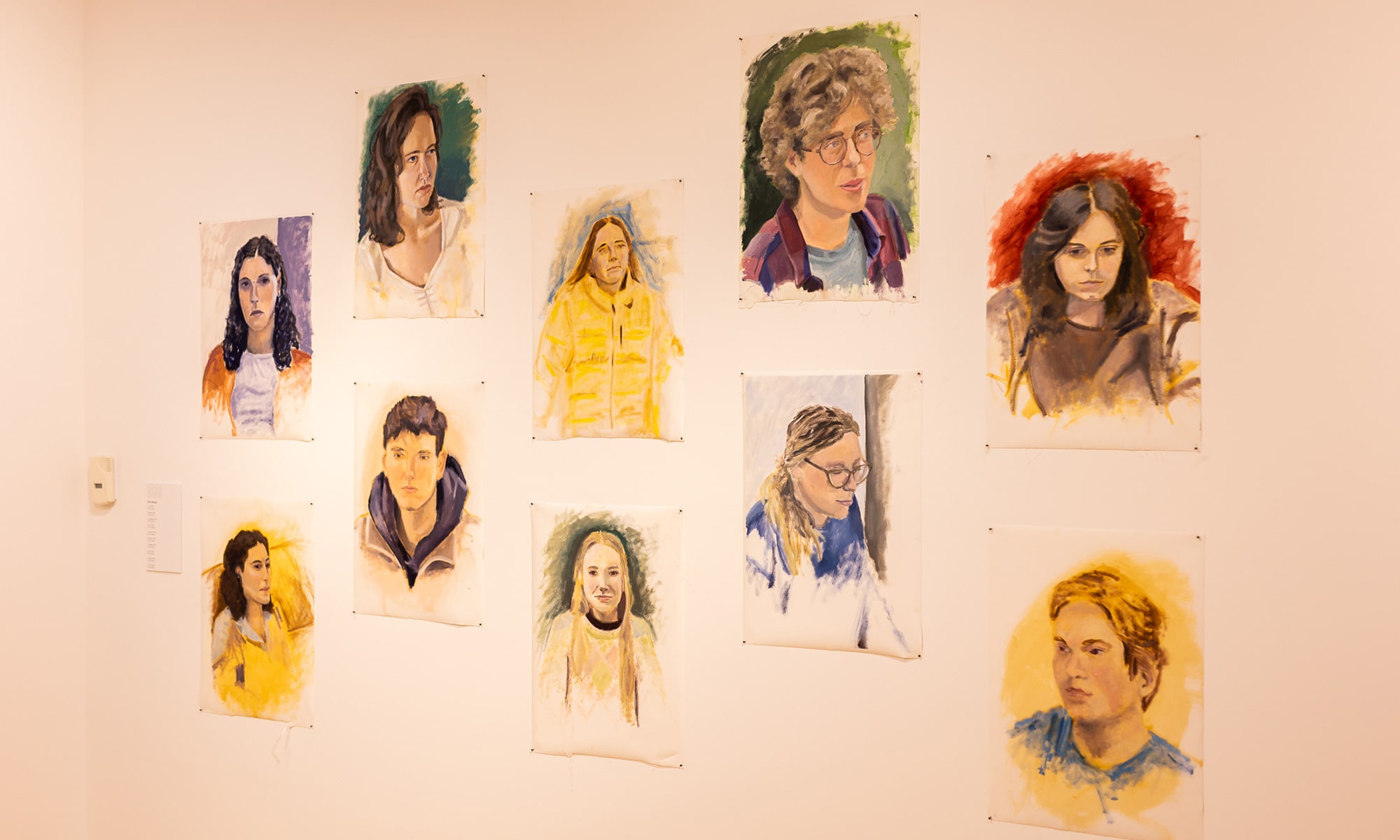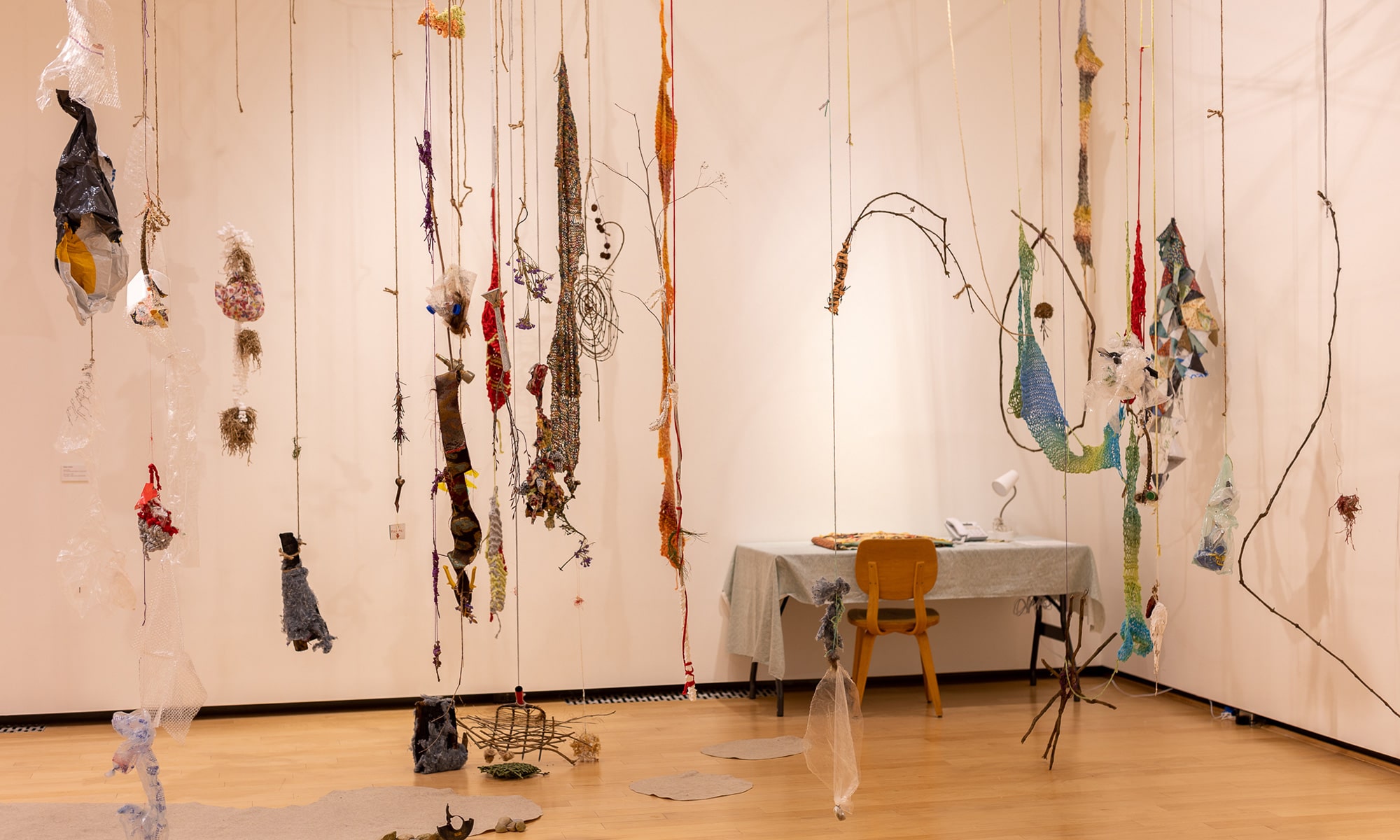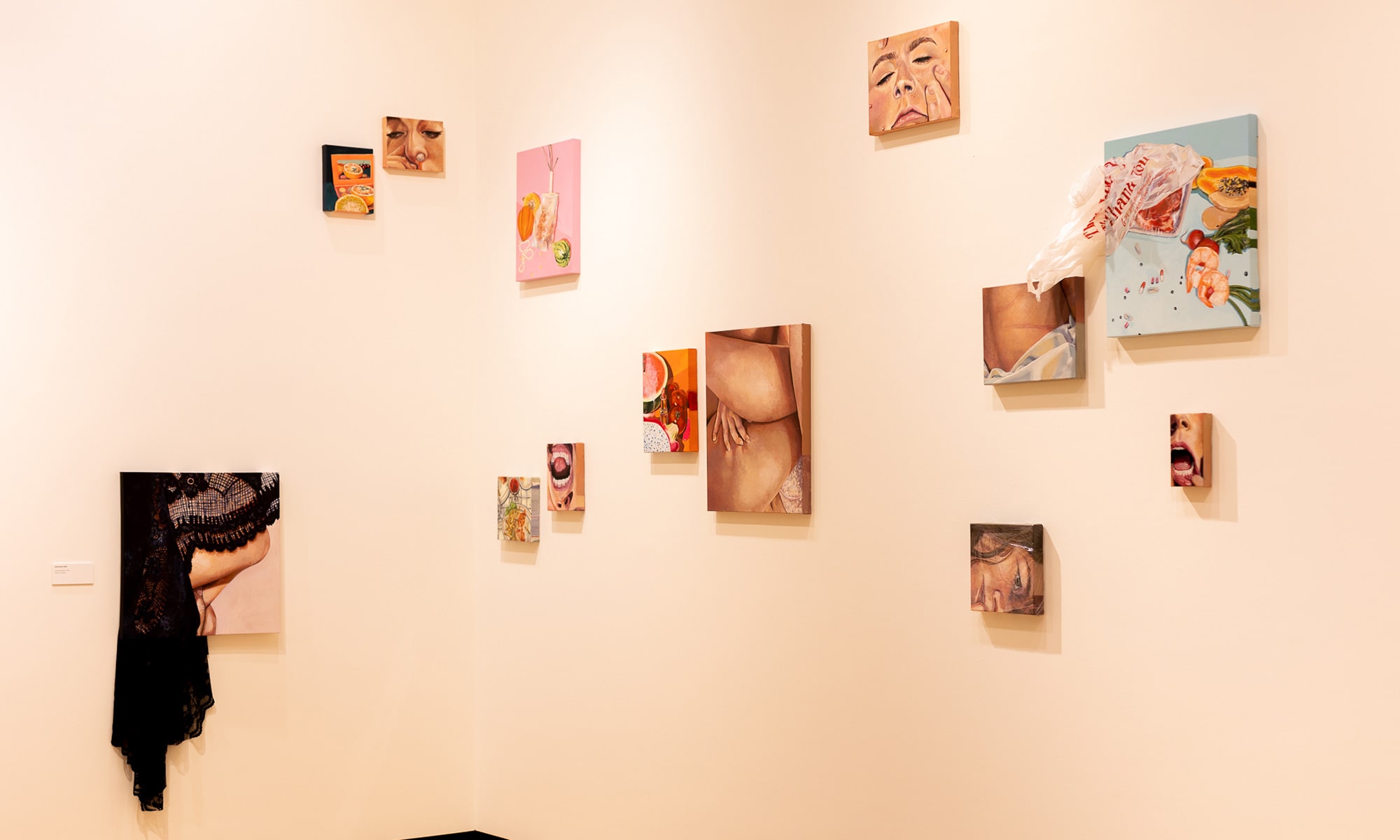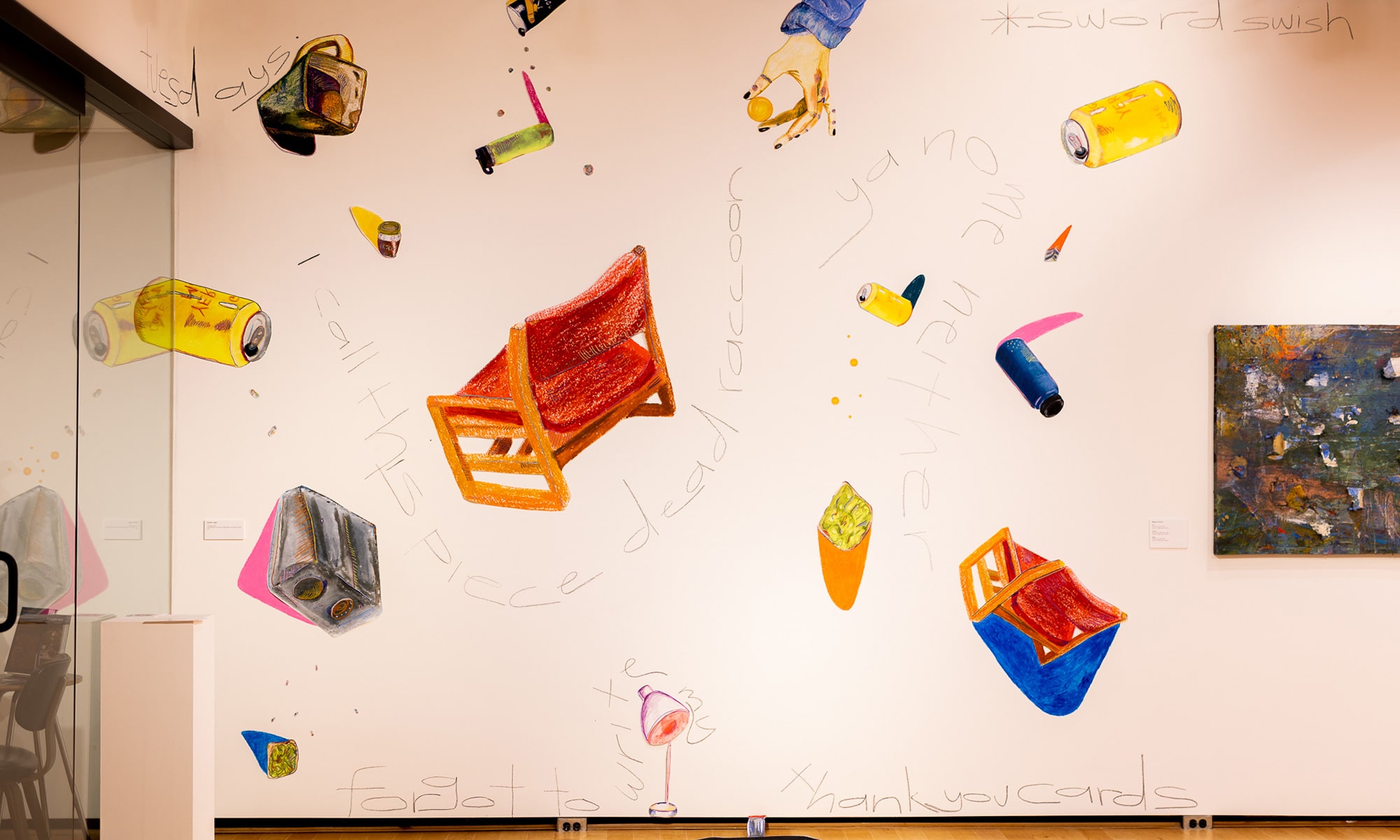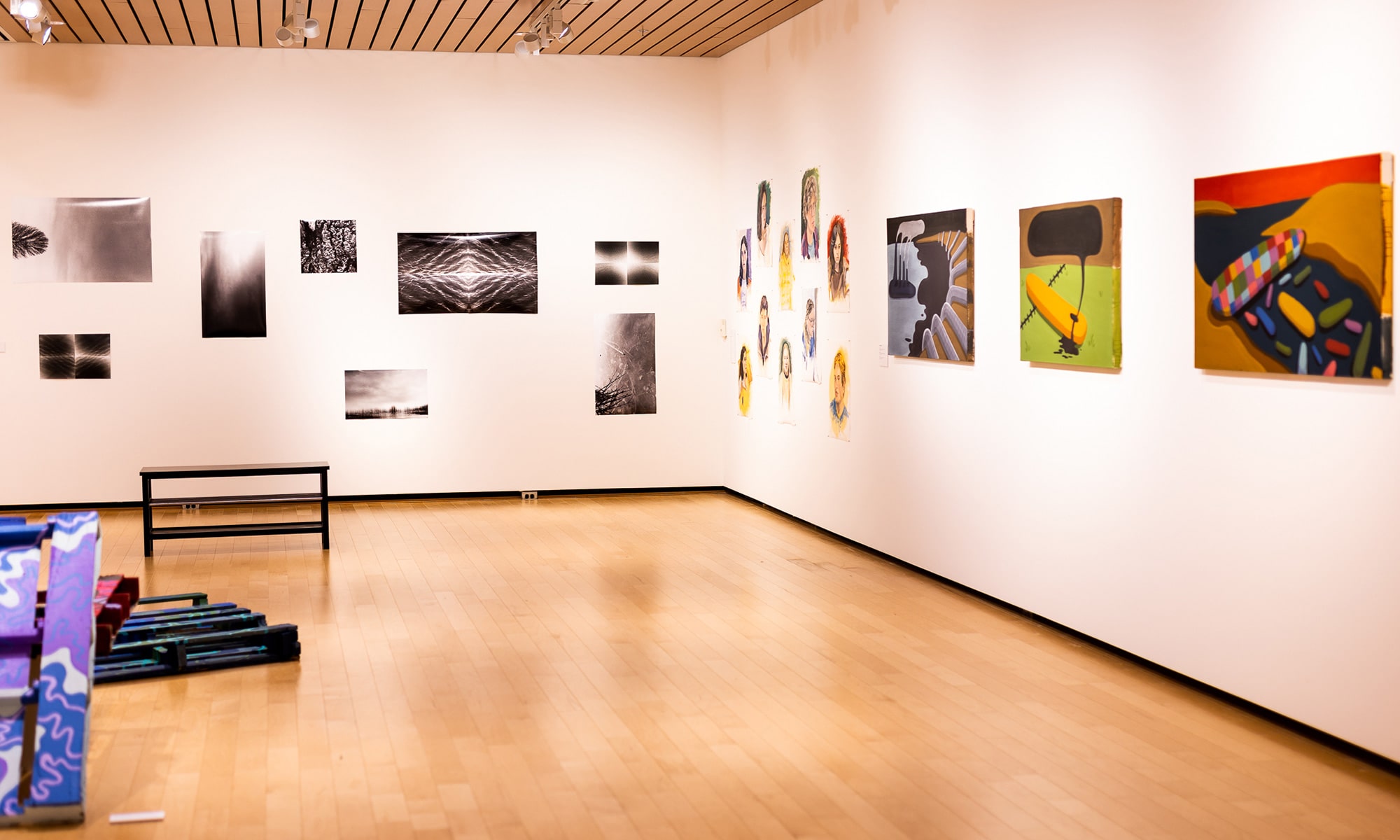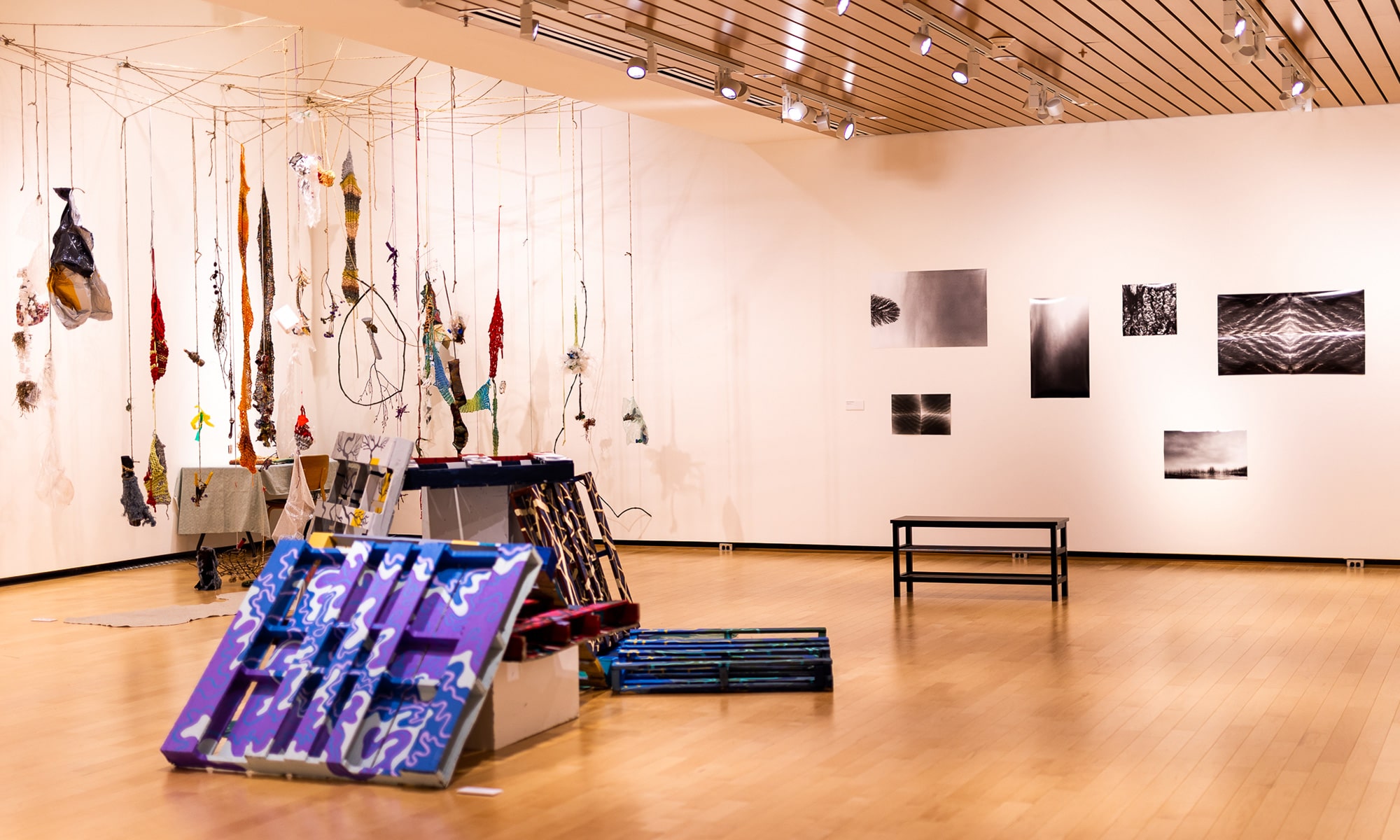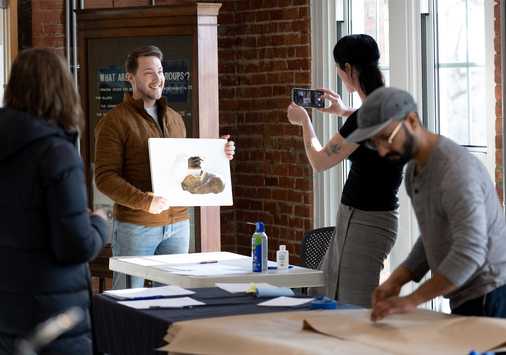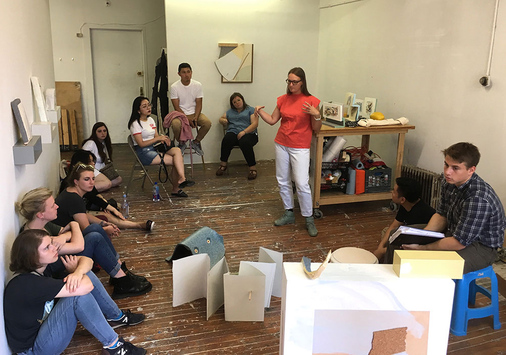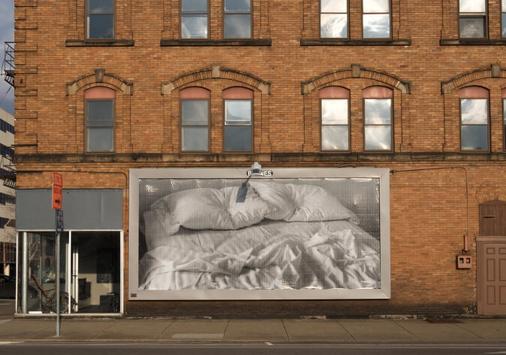
The Studio Art Senior Exhibition, “What Do We Know We Want?”, will be opening on Friday, April 21st from 4:30-6:30 p.m. at the Denison Museum.
The exhibition features the work of Studio Art senior majors Fatimah Bey, Skyler Cohen, Maisie French, Lexi Hall, Ryan Metzger, Ellie Schrader, Aileen Schretzmayer, Sophie Tight and Oliver Del Sesto.
The exhibition is free and open to the public and can be viewed until May, 12, 2023.
As the faculty member leading this group to present the WDWKWW exhibition at the Denison Museum, it has been with great pride and honor. This past semester I have had the chance to work with a wonderful group of students, exchanging ideas, growing together and forming an artistic community. Beginning in January we set our compasses on a journey working toward producing this exhibition. During this time, I have had the privilege to witness these students focus to develop their studio practice and engage in research developing their unique and personal approach to making art. Culminating in this exhibition, the work presented is a capstone of dedication to artistic, intellectual and personal growth.
Students: I am proud of you! Over this past year I have witnessed your commitment to making work that is real to you and filled with personal and cultural meaning. Doing this work you have been taking creative risks with material and process. Most of all, how you put your hearts and mind to what you have been doing. I commend you for putting together this exhibition and the work you have done over the past two semesters. Many kudos and congratulations for making this meaningful journey.
-Professor JSTN CLMN, Spring Practicum Prof.
Artist Statements
Fatimah Bey is a multifaceted artist from the southside of Chicago, Illinois. She grew up as the sixth of ten children, and she is a first-generation student. Fatimah’s primary medium is painting, although she also utilizes ceramics and photography within her artistic practice. Throughout Fatimah’s childhood, she was recognized for her artistic practice and development. She often received awards throughout primary and secondary school for the artwork that she created. Fatimah’s passion for art can be attributed to her eldest sister, an avid artmaker who watched Fatimah develop her art practice from a very young age. Her older sister’s extravagant landscape drawings and portraits inspired Fatimah to begin making artwork on her own. Fatimah has wanted to pursue a career in the arts since she was young.
My siblings are a huge part of my life, and in this work, I aim to celebrate them and the relationship that we share.
The presented pieces represent the experiences, traumas, and joyful moments that my siblings and I had as children. These depictions are some that I chose to highlight the relationships that I had between myself and those around me during these times in my childhood. I view these paintings as a means to connect more with my earlier experiences and those of my siblings. These paintings work to understand better and contextualize the relationships between those around us; this is achieved through the utilization of color. I explore color as a means to articulate better the familial connection between those who are depicted in the painting. In some cases, the colors are different. This use of color serves as a tool to denote proximity and closeness.
In all, these paintings have served me in being able to connect and honor the connection that I have with my siblings.
Sky Cohen is a Studio Art and Environmental Studies double major from Highland Park, IL. At Denison they have focused on exploring environmental ideas through visual arts. They are the president of Green Team, an Environmental Studies Senior Fellow and a member of the Phi Beta Kappa honor society. After graduation, they plan on joining an intentional community where they will continue making art and learning about diverse social organizations.
In this installation, viewers are invited to walk through a hanging forest made of comforting and discomforting objects, woven together in a complex web. The hanging sticks, metals and textiles are all seemingly disparate elements, although when one moves, they all move together, emphasizing the irrefutable unity of the human and the non-human. Beyond emphasizing our connections to each other, the movement reinforces the undeniability of how the self in a network can impact environmental destruction, as well as our enormous potential to create meaningful environmental change. The forest ends with a colorful and welcoming book. The book, “reconnection” functions as an abstracted proposal of the above. While this book is wordless, it becomes highly specific to our current eco-culture through narration. The phone provides an intimate but strangely disconnected way to through which to hear the story.
These objects have a deeply personal meaning as well. The hanging forest moves from plastic-ridden, to artificial-natural hybrid objects, to natural and cozy textile combinations as one walks. This reflects my own journey in making and reconnecting, from growing up in the suburbs, where our lawn could exist anywhere in the country, to knowing the Homestead woods, who lives there, and how I relate to them.
Oliver Del Sesto is a Studio Art BA from Washington, D.C., with an appreciation and a specialty in abstract painting and sculpture inspired by forms and patterns appearing in nature. His work draws connections to fluid forms appearing in topog- raphy and natural phenomena with the intent to generate a deeper respect and appreciation for the mundane aspects of nature that surround us all.
My abstract paintings on canvas and pallets serve as a representation of natural occurrences appearing all over the world consisting of fractals found in the silhouettes of branches and dessert mud cracks, curving and flowing forms of channels and rivers, distinct color relationships found in cave systems, and the in- interconnection of the man-made world and the natural world as one. These abstract depictions serve as a means to demonstrate these banal natural scenes with a more enriched color palette and with the intent to generate conversation on other associations created in the work. The abstraction of the pallets is both in form and in color. I analyzed imagery of natural phenomena from locations worldwide and intentionally used colors that were involved in their imagery accompanied by their opposites, to create a diverse and complex composition. While my paintings demonstrate similarities with forms appearing in oceanography, camouflage, and psychedelic euphoria, both in color and shape, they are meant to be analyzed and debated so that viewers can find their own meaning within the work.
These natural abstraction paintings are made from materials that were either found or donated, consisting mainly of house paints and pallets, which are recycled and used to portray the longevity and utility of recycled materials. When working I put a large amount of care and respect into the pieces because all of my materials had their own previous lives and purposes and deserve respect for the sustainable contribution to the work. In this same regard, I want my viewers to gain a deeper understanding of the interpretations created from natural aspects seen in the world and an appreciation for the journey of the material. While broken pallets and old paints are usually seen as useless, inconvenient, or unsightly, they are rejuvenated to show that their complexities and imperfections contain a new level of beauty and purpose, shown through the interpretation of our world in a new light.
Maisie French was born and raised in Indianapolis, Indiana pursuing a BA in Studio Art. Throughout her time at Denison she has focused on different mediums like ceramics, print-making, and sculpture. She is now focusing on abstract painting. Her work focuses on themes of grief, spirituality, human experiences, and her own experiences.
Grief is a cycle that is present in the life of every person whether that is conscious or not. Personally, I have experienced grief since very early stages of my life with my parents getting divorced while I was very young. My work is a continuation of an exploration of lived experiences of memories and grief through the lens of abstract expressionism. Imagination, emotions, and memories are relied on in the work to create my abstractions drawing focus on the individual marks made and the layering process throughout each abstraction.
In this work, I took thrifted canvases and transformed them by experimenting with different tools like brooms, squeegees, sponges, lids, sand, and pine cones, as well as different liquid materials like glue, hairspray, and vinegar. This creates unexpected results on the canvas and gives the work spontaneity and energy. This is juxtaposed with a process that requires patience and time to allow the materials to develop into new forms. The results are much like the time it takes to process grief. This turns the found paintings into new pieces of art while still leaving behind some of the original painting. I did this so that the previous life of the work lived is not taken away completely.
Each layer of paint is used to represent a different time in life, whether good or bad and then is peeled back. The peeled layers will either be visible or covered up. This is used to represent how I perceive that we as humans cover or hide a lot of the good parts of ourselves due to traumatic experiences. Sometimes we choose to let those parts of us shine through and sometimes we build up more layers to protect.
Lexi Hall is a Studio Art BA with minors in Communications and Creative Writ- ing from Pittsburgh, Pennsylvania. At Denison, she is a member of Delta Gamma so- rority, the Phi Beta Kappa Senior Honor Society, Mortar Board Senior Honor Society, Sigma Tau Delta English Honor Society, and is also a photography teaching assistant. This summer, Lexi is looking forward to starting the MFA in Children’s Book Writing and Illustration program at Hollins University in Roanoke, VA. Her favorite practicum memory is when Ryan did a high kick and fell down like a cartoon character on a late night in the studio before critique.
There isn’t a time in my life I can remember when I wasn’t concerned about my body or the way that I look. In investigating the root of this obsession, my culminating body of work seeks to dissect society’s commodification and hypersexualization of women’s bodies and reject the male gaze I have felt so compelled to appeal to. These paintings critique male gaze by employing stereotypical indicators of beauty and inquire about this with an unapologetic and bizarre self-portraiture that defies societal standards portrayed by the media and places an emphasis on the hyper-feminine versus the “unattractive.” In my paintings, I incorporate items that work as visual symbols of the greater oppressive nature of objectification and gender roles, twisting and exaggerating the visual expectations for both women’s bodies and painting. In distorting images of the feminine self and pairing them with items typically perceived as edible or strictly gendered, I investigate the absurdity of our cultural appetite for perfection, and undermine previous connotations we carry with the concept of portraiture with women subjects.
By allowing myself to fill the canvas in an abstracted series of self portraits, I expose my own intimate experience of insecurity and frustration regarding my own body. In pairing these intimate selves with hyper-saturated still lifes composed of fruits, cosmetics, jewelry, fabrics, and plastics, I take back and reinterpret stereotypes of a commercialized femininity. The detrimental effects of societal standards for women enter this work in an intersection between the seductive and grotesque to make undeniably visible the lasting harm done to feminine flesh. These depictions foretell a narrative of confidence and dominance, giving my representation of the feminine self a new level of power and autonomy. She refuses the leering judgment of society and persists, despite the intrusion of these symbolic objects that attempt to objectify her.
Ryan Metzger is a Studio Art BFA from Westerville, Ohio. At Denison, his artistic practice has primarily focused on figurative painting, something which was greatly informed by his semester abroad painting in Aix-en-Provence, France. Additionally, Ryan has worked on campus in the Bryant Woodshop for three years and works as an assistant preparator at CAM Gallery in Columbus. Following graduation, he plans to stay in Columbus to pursue a career in the fine arts and continue developing his studio practice.
My figurative oil paintings aim to go beyond mere physical likeness and capture the essence of my subjects’ character, while also emphasizing the unique and intimate relationship between painter and model. In my experience, capturing these invisible characteristics isn’t achieved through tediously long sessions, strenuous precision, or delicate mark-making, but through observational renderings, impetuous intuition, and bold, expressive forms. By utilizing intentional color choices that are quickly applied in loose brushstrokes, I explore the human form as a subject of artistic inquiry. Essentially, these artworks act as heartfelt tributes to friendship, ex- pressing manifestations of love in a way that is both individual and tangible.
These paintings can be seen as contemporary contributions to an art theory that values spontaneity and direct observation over exact likeness. By taking inspiration from the masters of French Impressionism and alla prima portrait painters like John Singer Sargent and Anders Zorn, I feel that I am able to tap into a rich artistic tradition that continues to resonate with contemporary audiences. Though portraiture was once only reserved for nobility and the upper echelon of society, impressionism was founded in opposition to this sort of academic painting. It is these works, depictions of everyday people, that I feel my paintings are most in conversation with. I am similarly inspired by contemporary painters like Jenna Gribbon, Jordan Casteel, and Lynette Yiadom-Boakye who utilize fluid and gestural mark-making to represent their subjects in expressive, nuanced fashions. I strive to pay homage to these master painters while also forging my own path, creating portraits that speak to the complexities of the human experience and engage with contemporary artis- tic practices.
Ellie Schrader is a Studio Art BFA from Bloomfield Hills, Michigan. During her time at Denison, Ellie has worked as both a collections intern at the Denison Mu- seum and Risograph assistant operator in addition to being a Bullsheet editor and member of the Kappa Delta Pi Art Honor Society. Her life after Denison will ideally involve continuing to work in museum collections, growing and refining her artistic practice, and doing really awesome stuff like paying off student loans.
The body of work presented investigates the abstraction of tragic events. I reflect upon and channel the absurdity of the constant bombardment of calamities in news cycles and the resulting cultural desensitization to disaster, employing subtle humor to make these crises more digestible. Here, comedy becomes a doorway leading into the serious: it draws audiences’ attention, disarming them of their discomfort, ultimately allowing the enormity of tragedy to become accessible, relatable, and palatable.
In deviating from realist imagery, the stark contrast between absurd abstraction and serious topic matter forms the base of humor that this work builds upon. Central forms and elements are reduced to simplistic forms that are not immediately recognizable, only to be clarified and contextualized by titles. I find that in the relationship between language and image is where the work’s humor again presents itself: whereas the text is literal and maturely matter-of-fact, the image is ambiguous or in some instances, childish. It is here that dynamics of “the rational and irrational, the expected and unexpected” emerge, “the same tensions created in a joke.” (Eve Adsetts, “Weird Nonsense: Humor and Trauma in the Work of Eva Hesse) Laughter thus becomes the release of internal tensions rooted in severity.
Stylistically, I pay close attention to how colors serve to further a narrative by implicating specific emotions, senses, or concepts. New associations with and understandings of the events begin to form, adding to the collective memories of their occurrences. East Palestine Trail Derailment, for example, uses dark, earthy colors to translate a sense of pollution and corruption, whereas Deepwater Horizon Oil Spill employs cold, somber colors to reflect its grave impact on wildlife health and mortality.
Aileen Schretzmayer is a Studio Art BFA from Long Island, New York. At Denison she has focused on photography through a narrative based lens. Her work is primarily influenced by contemporary portraiture and narrative photography. During her time as Denison, Aileen was a part of the Women’s Varsity Cross-country and Winter/ Spring Track Team, and worked in the photography department as a teaching assistant. This summer Aileen plans to move to New York City for Pratt Institute’s MFA photography program.
I am an artist invested in telling stories and narratives through my own lens.
My photographs include seemingly banal spaces presented in various experimental ideas. These close-ups create unexpected juxtapositions, in order to blend fantasy and fiction, which form new narratives that inhabit liminal spaces within my mind. These photographs focus on the surreal aspects that the memory of Infirmary Mound holds for me. I have spent time returning to this specific location in hopes of capturing unknowingness within this realm. The more I return, the more it becomes abstracted.
In thinking how a site or space can reflect certain ideas or concepts, new messages, and meanings are evoked through the utilization of an analog camera and film. Analog chemical processes create an image that allows me to create abstractions through analog techniques such as dodging and burning. By creating triptychs, diptychs, collages, and layers, my photographs begin to rub together and formulate new habitations of spaces. Through overlapping, contrasting, and connecting, I create a greater collective sense of unknowingness.
Sophie Tight is a Studio Art Major and a History Minor from San Rafael, California. While her artistic education has varied from sculpture to photography to Stop-Motion, Sophie’s focus has become prominently Illustration. During her time at Denison, Sophie has played 4 years of Varsity Volleyball, worked in the ceramics department as a TA, and also does graphic design work through various opportunities. After Denison, Sophie looks forward to finding new ways in which her creativity and terrible jokes can be utilized in an exciting and motivating environment.
There is an abundant and rich amount of information experienced during the every day. My work examines this richness through whimsical depictions that are recorded with handwritten text and illustrations as a nod to the visual and auditory. These passing ideas are fused in the present, that often juxtapose the brightness of the immediate and the personal, often comically deprecating commentary.
Everything starts in my sketchbook and is drawn, printed and redrawn in order to hold these experiences in time as reflective points.
The subject of my illustrations capture ordinary moments witnessed, as well as imagined portrayal of my inner monologue and commentary. I use uninhibited wit to create an expressive, colorful world where the line is blurred between captured scenes and imagined dialogue. This further examines the fleeting nature of a moment and the lens in which we encounter and narrate our lived experiences.
